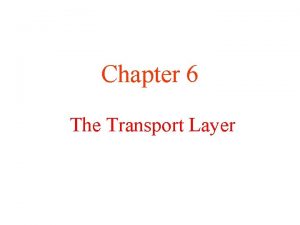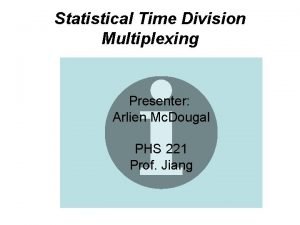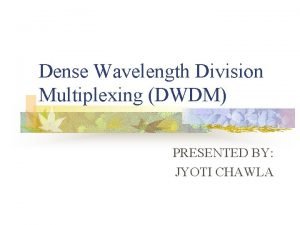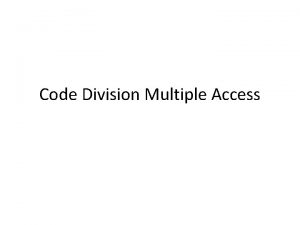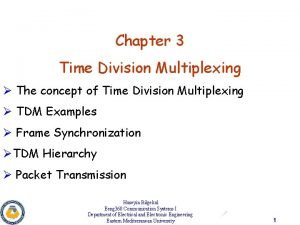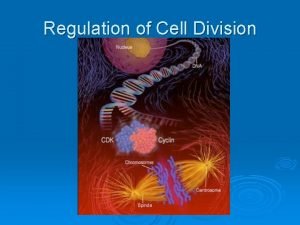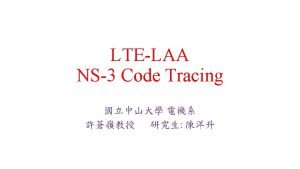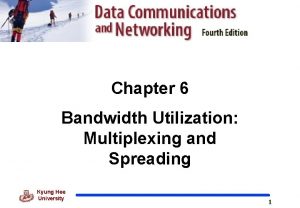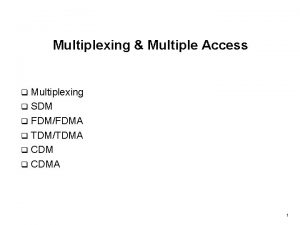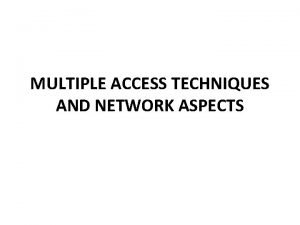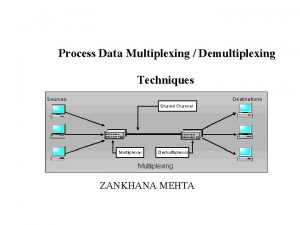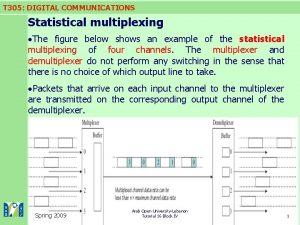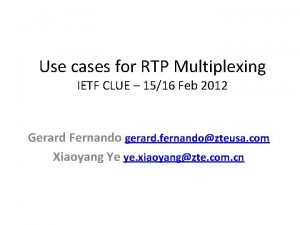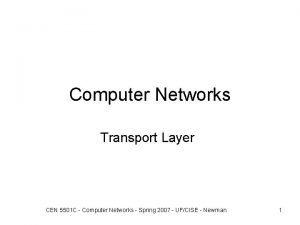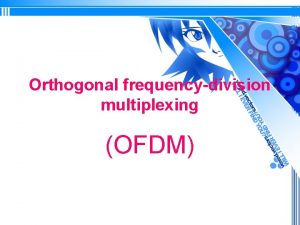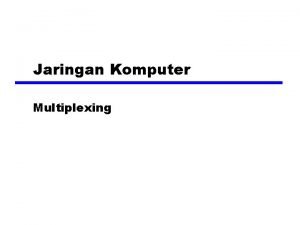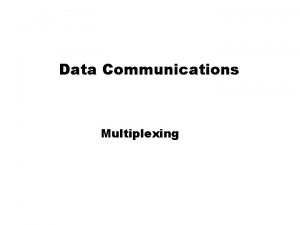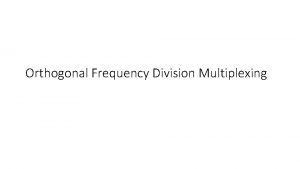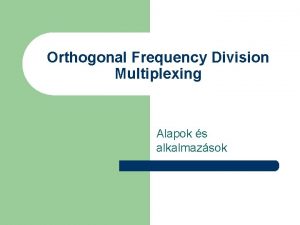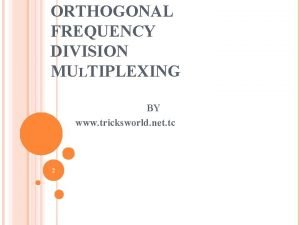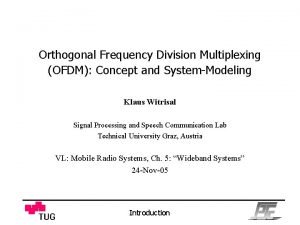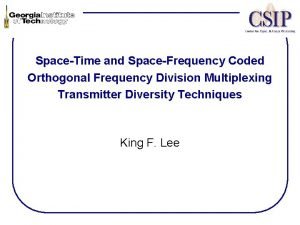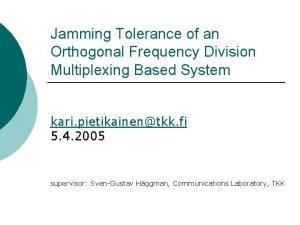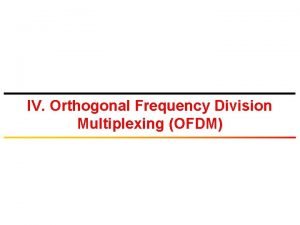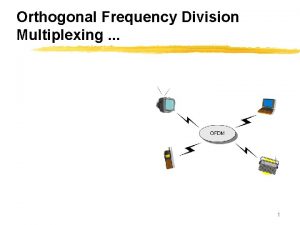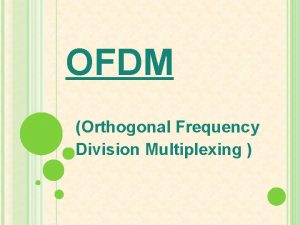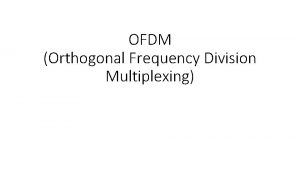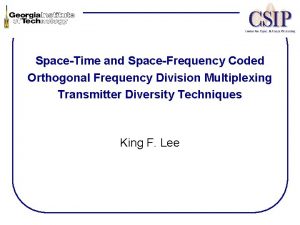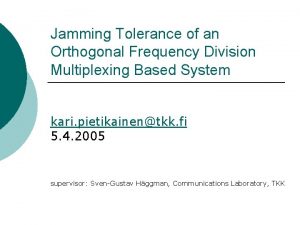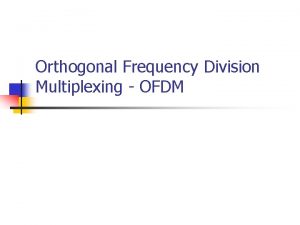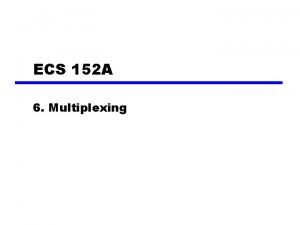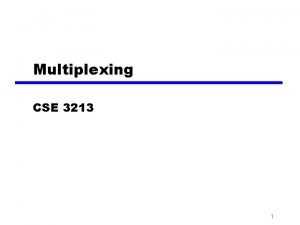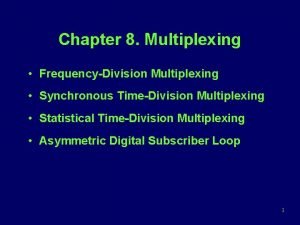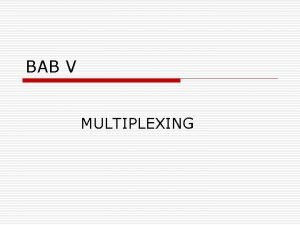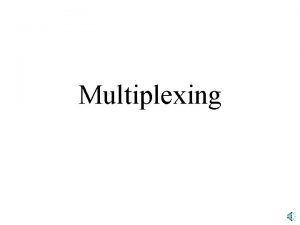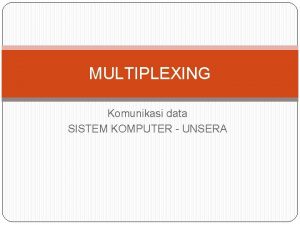Orthogonal Frequency Division Multiplexing for Indoor Optical Wireless












![OFDM - Cyclic Prefix (CP) • OFDM signal with CP is x[n]L, and so OFDM - Cyclic Prefix (CP) • OFDM signal with CP is x[n]L, and so](https://slidetodoc.com/presentation_image_h/92fdd43043ca55129ecdbdead4efb620/image-13.jpg)












![Received LOS Power Maximum_power = 1. 2270 [d. Bm] Minimum_power = -5. 2891 [d. Received LOS Power Maximum_power = 1. 2270 [d. Bm] Minimum_power = -5. 2891 [d.](https://slidetodoc.com/presentation_image_h/92fdd43043ca55129ecdbdead4efb620/image-26.jpg)

- Slides: 27

Orthogonal Frequency Division Multiplexing for Indoor Optical Wireless Communications using Visible Light LEDs S. K. Hashemi 1, Z. Ghassemlooy 1, L. Chao 2, and D. Benhaddou 3 1 Optical Communications Research Group, NCRLab, Northumbria University, Newcastle upon Tyne, UK Web site: http: //soe. unn. ac. uk/ocr 2 Department of Electronic and Information Engineering, Hong Kong Polytechnic University 3 Engineering Technology Department, College of Technology, University of Houston, USA 1 CSNDSP 2008

Contents • • Introduction Optical Wireless Communication (OWC) Links Combating Inter-symbol Interference OFDM Channel Estimation Simulation results Conclusions 2 CSNDSP 2008

Introduction • Invented more than 40 years ago. • Has been adopted for several technologies: – Asymmetric Digital Subscriber Line (ADSL) services. – IEEE 802. 11 a/g, IEEE 802. 16 a. – Digital Audio Broadcast (DAB). – Digital Terrestrial Television Broadcast: DVD in Europe, ISDB in Japan – 4 G, IEEE 802. 11 n, IEEE 802. 16, and IEEE 802. 20. 3 CSNDSP 2008

OWC Links LOS § LOS Rx Non-LOS Tx §No multipath Propagation §Only noise is limiting factor §Possibility of blocking §Tracking necessary to maintain LOS link Tx Rx Multipath Propagation § Intersymbol interference (ISI) § Difficult to achieve high data date due to ISI CSNDSP 2008

Techniques to Overcome ISI • Guard slots - in digital modulation (PPM, PIM) • Spread spectrum - at the expense of reduced bandwidth efficiency • Angle diversity - based on multibeam-narrow field-of-view (FOV) transceiver • Adaptive decision equalizer • USE of multi-carriers transmission – In this paper we investigate OFDM system where multipath induced ISI and the effects of background noise are reduced by taking the advantage of narrowband frequency interference, which affects only one of the frequency sub-bands when compare to the single-carrier modulation. 5 CSNDSP 2008

OFDM • OFDM mainly used in RF based wireless communication schemes offering – high data rates capability – high bandwidth efficiency – and capable of dealing with the multipath induced ISI [9] • Has been proposed in optical wireless communication systems [10] • Uses a large number of closely-spaced orthogonal sub-carriers, each modulated at a low symbol rate 6 CSNDSP 2008

OFDM - Types Wideband-OFDM (W-OFDM) of Wi-LAN www. wi-lan. com -- 2. 4 GHz band -- 30 -45 Mbps in 40 MHz -- large tone-width (for mobility, overlay) Flash OFDM from Flarion www. flarion. com -- Freq. Hopping for CCI reduction, reuse -- 1. 25 to 5. 0 MHz BW -- mobility support Vector OFDM (V-OFDM) of Cisco, Iospan, etc. www. iospan. com -- MIMO Technology -- non-Lo. S coverage, mainly for fixed access -- upto 20 Mbps in MMDS • Wi-LAN leads the OFDM Forum -- many proposals submitted to IEEE 802. 16 Wireless MAN • Cisco leads the Broadband Wireless Internet Forum (BWIF) 7 CSNDSP 2008

OFDM Signal Conventional multicarrier techniques Ch. 1 Ch. 2 Ch. 3 Ch. 4 Ch. 5 Ch. 6 Ch. 7 Ch. 8 Ch. 9 Ch. 10 Frequency Orthogonal multicarrier techniques Ch. 2 Ch. 4 Ch. 6 Ch. 8 Ch. 10 Ch. 1 Ch. 3 Ch. 5 Ch. 7 Ch. 9 50% bandwidth saving Frequency 8 CSNDSP 2008

OFDM - Spectrum • The FFT (and its inverse, the IFFT) are used to create a multitude of orthogonal subcarriers using just a single TX. • Subcarrier orthogonality must be preserved in the presence of Magnitude – timing jitter – frequency offset – fading. T 0 Frequency 9 CSNDSP 2008

Optical OFDM System Architecture Pilot signals uniformly inserted into all symbols (sub-carriers) for channel estimation for diffuse optical links only. 10 CSNDSP 2008

OFDM • IFFT converts X(k) of length N into a complex time-domain OFDM signal. • In order for the IFFT/FFT to create an ISI-free channel, the channel must appear to provide a circular convolution. To mitigate the effects of multipath induced ISI, a guard interval of G-sample (or cyclic prefix (CP)) is inserted between symbols. The length of CP depends on the channel delay spread and is normally considered to be grater than or equal to the channel length (impulse response time) and less than symbol duration • • 11 CSNDSP 2008

Circular Convolution & DFT/IDFT • Circular convolution: • Circular convolution allows DFT! • Detection of X (knowing H): (note: ISI free! Just a scaling by H) 12 CSNDSP 2008
![OFDM Cyclic Prefix CP OFDM signal with CP is xnL and so OFDM - Cyclic Prefix (CP) • OFDM signal with CP is x[n]L, and so](https://slidetodoc.com/presentation_image_h/92fdd43043ca55129ecdbdead4efb620/image-13.jpg)
OFDM - Cyclic Prefix (CP) • OFDM signal with CP is x[n]L, and so y[n] = x[n] * h[n]. First v samples of ycp interference from preceding OFDM symbol => discarded. q The last v samples disperse into the subsequent OFDM symbol => discarded. q This leaves exactly L samples at output y, to recover the L data symbols embedded in x. 13 q CSNDSP 2008

OFDM • The received OFDM signal propagated through the channel h(n) is given by: • where w[n] is the additive white Gaussian noise, is the photodetector responsivity, and denotes the circular convolution. Channel models: • Recursive algorithm to take into account higher order reflections [11], • MIMO method for speedy calculation of the impulse response [12]. • Mont Carlo ray-tracing algorithm and its modified version uses both the Lambert’s diffuse and the Phong’s models to approximate surfaces with a strong specular component [13 -14]. • The Sphere model in [15] • Fast iterative model capable of calculating high-order reflections [17]. 14 CSNDSP 2008

OFDM - Channel Estimation • Time 1) Block-type - all sub-carriers is used as pilot in a specific period. It uses the least square (LS) or the minimum mean-square error in a slow fading channel [18]) 2) Comb-type - part of the sub-carriers are always reserved as pilot for each symbol, and it uses LS with interpolation and the maximum likelihood in a rapidly changing channel [19]) - Adopted Block type Carriers Comb type Time With no knowledge of the channel, channel estimation is required for equalization and decoding provided. • In one dimensional channel estimation schemes, pilot insertion is done in Carriers 15 CSNDSP 2008

OFDM – Interpolation Schemes • Pilot symbols uniformly inserted into symbols according to • Information on the exact locations of the pilot and data symbols as well as the values of the pilot symbols are already available at the receiver. • • The estimated channel at pilot subcarriers for the LS estimation (no need of prior knowledge of noise variance) is given as: • • Interpolation schemes – – linear interpolation, second-order interpolation, spline cubic interpolation time domain interpolation which are used in the one dimensional model to extract channel information on the data sub-carriers Hd [18]. In [21, 23] detailed information on the number of pilots used and how to located them as optimal pilot design techniques are given. 16 CSNDSP 2008

OFDM - Simulation Transmitter Channel coding / interleaving 0110 Symbol mapping (modulation) 010101001 OFDM modulation (IFFT) I/Q Guard interval I/Q N symbols 1 OFDM symbol Receiver Decoding / deinterleaving symbol demapping (detection) Channel impulse Channel response: est. OFDM demod. (FFT) FFT-part Guard interval removal I/Q Time sync. I/Q time 17 CSNDSP 2008

Simulation Parameters Values No. of Les 4 Transmitted optical power Ps 20. 0 m. W Centre luminance intensity of LED 730 mcd Field of view (FOV) 60 o Photodetector surface area Ar 1 cm 2 Lambert mode 0. 6461 Concentrator refractive index nr 1. 5 Photodetector responsivity 0. 53 (A/W) FFT size 256 Number of data subcarriers 128 Number of pilots 16, 32, 64 Cyclic prefix (CP) ratio 1/4 The radiation pattern is assumed to be Lambertian 18 CSNDSP 2008

Horizontal Illuminance Distribution 19 CSNDSP 2008

Results - Error Performance for LOS optical wireless OFDM link employing BPSK, QPSK and 16 -QAM 20 CSNDSP 2008

Results – Error performance for diffuse OW OFDM link with QPSK & LS channel estimation for a number of pilot symbols 21 CSNDSP 2008

Conclusions • Visible light LED’s was proposed for both lightening and communication system • OFDM technique employed to combat ISI due to the multipath reflections • Due to the variation of the optical channel impulse response in OW links, pilot signals added and the channel is estimated. • We simulated the illumination to meet the ISO for lighting and found the number of LEDs for the simulation parameters. • Performance of the system for both LOS and Diffuse link for BPSK, QPSK and M-QAM was simulated. 22 CSNDSP 2008

Thank you! 23 CSNDSP 2008

Inter-Symbol-Interference (ISI) due to Multi-Path Reflections Transmitted signal: Received Signals: Line-of-sight: Reflected: The symbols add up on the channel Distortion! Delays 24 CSNDSP 2008

OFDM Symbols v Group L data symbols into a block known as an OFDM symbol. v An OFDM symbol lasts for a duration of T seconds, where T = LTs. v Guard period > delay spread v OFDM transmissions allow ISI within an OFDM symbol, but by including a sufficiently large guard band, it is possible to guarantee that there is no interference between subsequent OFDM symbols. v The next task is to attempt to remove the ISI within each OFDM symbol 25 CSNDSP 2008
![Received LOS Power Maximumpower 1 2270 d Bm Minimumpower 5 2891 d Received LOS Power Maximum_power = 1. 2270 [d. Bm] Minimum_power = -5. 2891 [d.](https://slidetodoc.com/presentation_image_h/92fdd43043ca55129ecdbdead4efb620/image-26.jpg)
Received LOS Power Maximum_power = 1. 2270 [d. Bm] Minimum_power = -5. 2891 [d. Bm] 26 CSNDSP 2008

OFDM Systems System FFT Size Number Carriers Channel Spacing k. Hz Bandwidth MHz Sample Rate MHz Symbol Duration sec Data Rate Mbits/s Hyper. LAN/2 64 52 4 312. 5 16. 25 20 3. 2 0. 8 6 -54 802. 11 a 64 52 4 312. 5 16. 56 20 3. 2 0. 8 6 -54 DVB-T 2048 1024 1712 842 4. 464 7. 643 9. 174 224 0. 68 -14. 92 DAB 2048 8192 1536 1. 00 1. 536 2. 048 24/48/96 msec 3. 072 ADSL 256 (down) 64 (up) 36 -127 7 -28 4. 3125 1. 104 231. 9 0. 64 -8. 192 27 CSNDSP 2008
 Long term evolution advanced
Long term evolution advanced Upward multiplexing
Upward multiplexing Upward and downward multiplexing
Upward and downward multiplexing What is statistical time division multiplexing
What is statistical time division multiplexing Dwdm system block diagram
Dwdm system block diagram Code division multiplexing
Code division multiplexing In tdm systems, channel separation is done with the use of
In tdm systems, channel separation is done with the use of What are wireless devices and the wireless revolution
What are wireless devices and the wireless revolution Relative frequency bar chart
Relative frequency bar chart Expected relative frequency
Expected relative frequency Joint frequency vs marginal frequency
Joint frequency vs marginal frequency Power of sine wave
Power of sine wave Relative frequency two way table
Relative frequency two way table How is linear frequency related to angular frequency?
How is linear frequency related to angular frequency? How to find conditional relative frequencies
How to find conditional relative frequencies Frequency of cell division
Frequency of cell division Fdd frequency division duplex
Fdd frequency division duplex Short division vs long division
Short division vs long division Synthetic division pattern
Synthetic division pattern Division
Division Sunthetic division
Sunthetic division Multilevel multiplexing
Multilevel multiplexing Difference between multiplexing and multiple access
Difference between multiplexing and multiple access Difference between multiplexing and multiple access
Difference between multiplexing and multiple access What is multiplexing and demultiplexing
What is multiplexing and demultiplexing Statistical multiplexing example
Statistical multiplexing example Rtp multiplexing
Rtp multiplexing Upward multiplexing
Upward multiplexing


